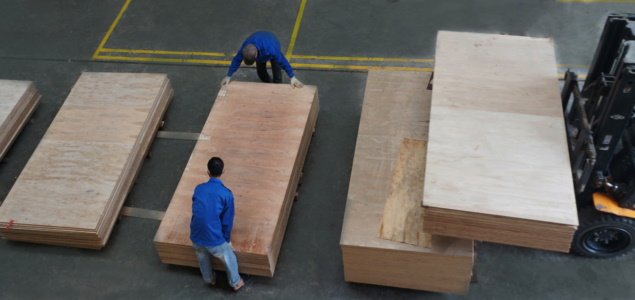In the year 2023, the raw wood import materials amounted to 4,523 million cubic meters, with a total value of 1,535 billion USD. This signifies a notable reduction of 24.5% in volume and a substantial 32.4% decline in value compared to the preceding year, 2022.
As per early data provided by the General Department of Customs, Vietnam imported 454.5 thousand cubic meters of raw wood materials in December 2023, for a total worth of 150.0 million USD. This signifies an 8.0% rise in volume and an 8.1% increase in value in comparison to November 2023. Nonetheless, in contrast to December 2022, there was a 3.3% growth in volume and a 4.6% decline in value.
To recap the year 2023, the import of raw wood materials totaled 4,523 million cubic meters, valued at 1,535 billion USD. This indicates a notable 24.5% decline in volume and a significant 32.4% decrease in value compared to the figures in 2022. Regarding import markets, during the initial 11 months of 2023, the volume of raw wood materials imported from prominent markets including the EU, China, the United States, Cameroon, Laos, Brazil, and others experienced a decrease compared to the corresponding period in 2022.
In contrast, the volume of imports from certain other markets rose, including Thailand, Chile, Sierra Leone, and more. Notably, the raw wood material imports from the EU market constituted 16.6% of the overall import volume, totaling 675.2 thousand cubic meters with a value of 205.2 million USD. This depicts a 12.9% reduction in volume and a 20.5% decrease in value when compared to the corresponding period in 2022.
The importation of this product from the Chinese market witnessed a decline of 17.8% in volume and 31.6% in value compared to the corresponding period in 2022, settling at 504.0 thousand cubic meters and 228.0 million USD, respectively. This comprised 12.4% of the total import volume. Similarly, the import of raw wood materials from the U.S. market experienced a decrease of 25.6% in volume and 32.9% in value compared to the same period in 2022, reaching 480.1 thousand cubic meters and 206.5 million USD, accounting for 11.8% of the total import volume.
Moreover, the volume of imports of raw wood materials from various other markets witnessed a decline compared to the corresponding period in 2022. This includes a 29.5% decrease from Cameroon, a 24.1% decrease from Laos, a 41.7% decrease from Brazil, a 5.8% decrease from New Zealand, a 20.6% decrease from Russia, a significant 71.9% decrease from Papua New Guinea, and so forth.
Conversely, the import of this product from certain other markets during the initial 11 months of 2023 exhibited an increase compared to the same period in 2022. Notable examples include a 4.5% rise from Thailand, an 11.4% increase from Chile, and an impressive surge of 126.9% from the Republic of Sierra Leone.
Concerning the categories of imports, during the initial 11 months of 2023, the volume of imported primary wood types like pine, teak, yang, oak, rosewood, mahogany, and maple experienced a decline in comparison to the same period in 2022. Simultaneously, the volume of imports for certain types witnessed an increase, including plywood, rosewood, agarwood, peach blossom wood, rattan, and lychee wood.
Regarding import prices, in the initial 11 months of 2023, the average import price of various raw wood materials in Vietnam stood at 340.3 USD/m³, indicating a 10.6% decrease compared to the corresponding period in 2022. More specifically, the import price of raw wood materials from the EU reduced by 8.7% compared to the same period in 2022, settling at 304.0 USD/m³; from the U.S., it experienced a 9.9% decrease, reaching 430.1 USD/m³; from China, it witnessed a 16.7% decline, amounting to 452.4 USD/m³; from Laos, there was a 7.7% decrease to 467.6 USD/m³, and so forth.
The decline in imports can be attributed to several factors, including sluggish global economic growth, inflation, and stringent monetary policies in key wood-consuming markets, thereby impeding the expansion of the wood industry. Additionally, challenges stem from elevated raw material costs, diminished demand for raw wood materials from processing plants, and an upswing in trade protection measures. The wood industry faces intensified competition among exporting nations.
Vietnam’s wood and wood product exports have confronted multiple challenges, exerting an impact on the import of raw wood materials. Presently, the domestic wood supply demonstrates relative stability, estimated to fulfill 75.2% of the demand for raw materials. However, the remaining 24.8% of wood necessitates importation.
Annually, Vietnam imports approximately 5–6 million cubic meters of roundwood. In contrast, the volume of wood harvested from domestically planted forests remains constant, hovering around 20 million cubic meters of roundwood. Nevertheless, Vietnam has not yet secured a substantial supply of wood from planted forests. Wood sourced from household-planted forests is predominantly of a smaller size and is frequently employed as an input material for wood chips and compressed pellets.
The outlook suggests a recovery in the import of raw wood materials for 2024, propelled by a more positive trajectory in the global economy, diminishing inventory levels in crucial markets, and an upswing in the real estate sector. Concurrently, there exists substantial potential for the expansion of wood and wood product exports in the foreseeable future, underlined by the vast scale of the global timber and furniture market, which is anticipated to reach a valuation of up to 200 billion USD.
Source: goviet.org.vn




